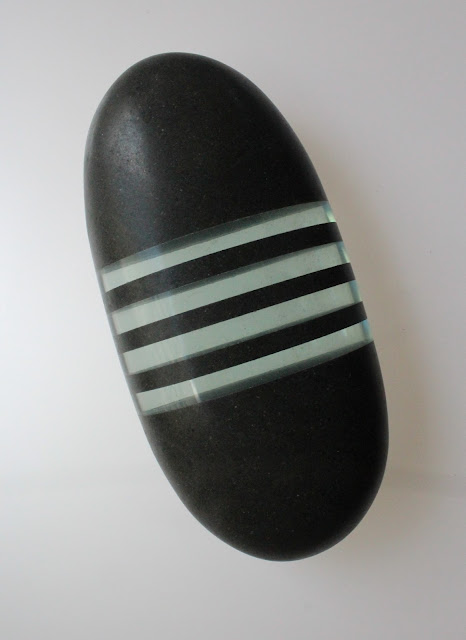A friend who scours the second-hand shops found this quite remarkable sculpture by glass artist Tony Kuepfer in the Hospice Shop in New Plymouth. It reminds me of the 'Mr Potato Head' toys of the 1950s (and more recently).
It is clearly signed and dated AWK (Tony Kuepfer's initials) '76 NZ, which makes it an early piece of Tony's work.
Tony has confirmed that it pre-dates the visit in March 1977 by English gaffer Fred Daden (see my November 2016 Blog about that visit and the wonderful film made in Tony's studio http://newzealandglass.blogspot.co.nz/2016/11/fred-daden-and-tony-kuepfer-at.html).
Before Fred came, Tony was not well able to get his glass pieces sufficiently thin, and he could only form 'feet', for goblets or for sculptures, by dropping a gather of glass onto the marver [a flat iron plate], flattening it quickly, then picking it up on a rod to attach it to the object. This piece demonstrates that clearly - it is thick and heavy, and the foot was not made in the way Fred showed Tony how to do, as seen in the March 1977 film.
Tony has commented: "I sort of do remember making
this along with one or two other strange critters. Not much more to say other than having a
bit of fun and seeing how far you could push your rudimentary skills at the
time. I remember earning some critical comments from people like Don Driver about
producing this California Flash. Didn’t sit well with the craft community then
as the Bernard Leach strict school of fine craft was order of the day. Guess I
sort of rebelled against that attitude." Don Driver (1930 - 2011) was one of New Zealand's leading artists of the day, based in New Plymouth.
I bloggged about another 'Kwerky Kuepfer' in 2012 (https://newzealandglass.blogspot.com/2012/01/easter-egg-head-by-tony-kuepfer.html), but here it is again:
Tony called this an 'Easter Egg-Head'. It is better made than 'Mr Potato Head', less heavy and with better modelled features, but it shares the use of silver chloride colouration to depict the hair (and ears in the earlier piece).
 I just love this jug, which also has a sculptural quality. It is not dated, but Tony has suggested it was probably made "post Fred Daden visiting me in March '77... as I had to re-learn how to work glass". That is clearly still a work in progress, since the glass is very thick and heavy, but to me that adds to its charm.
I just love this jug, which also has a sculptural quality. It is not dated, but Tony has suggested it was probably made "post Fred Daden visiting me in March '77... as I had to re-learn how to work glass". That is clearly still a work in progress, since the glass is very thick and heavy, but to me that adds to its charm.















































